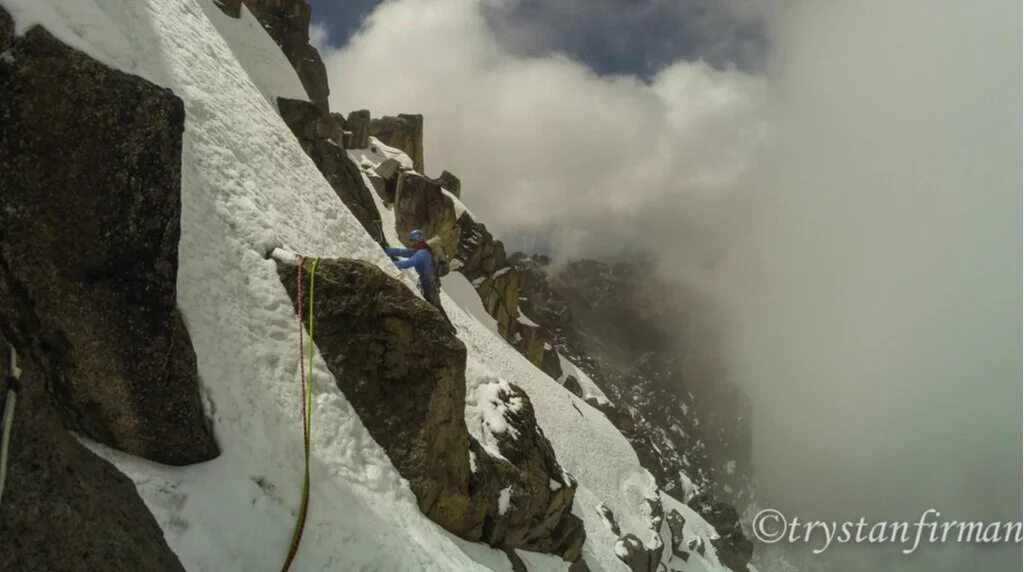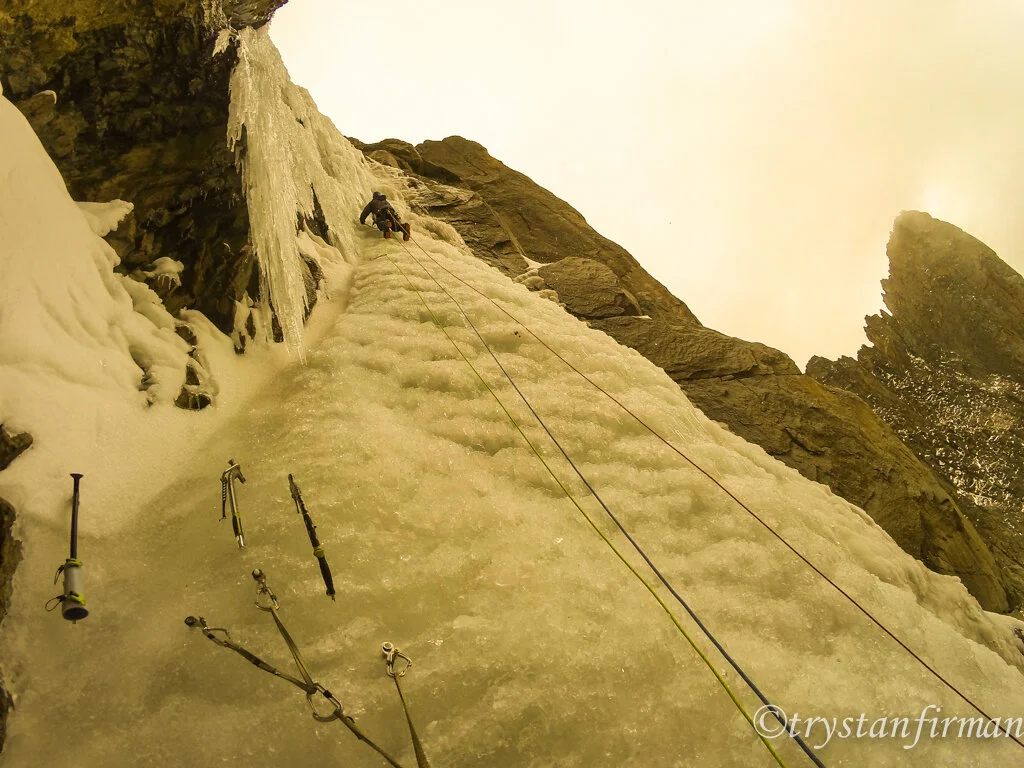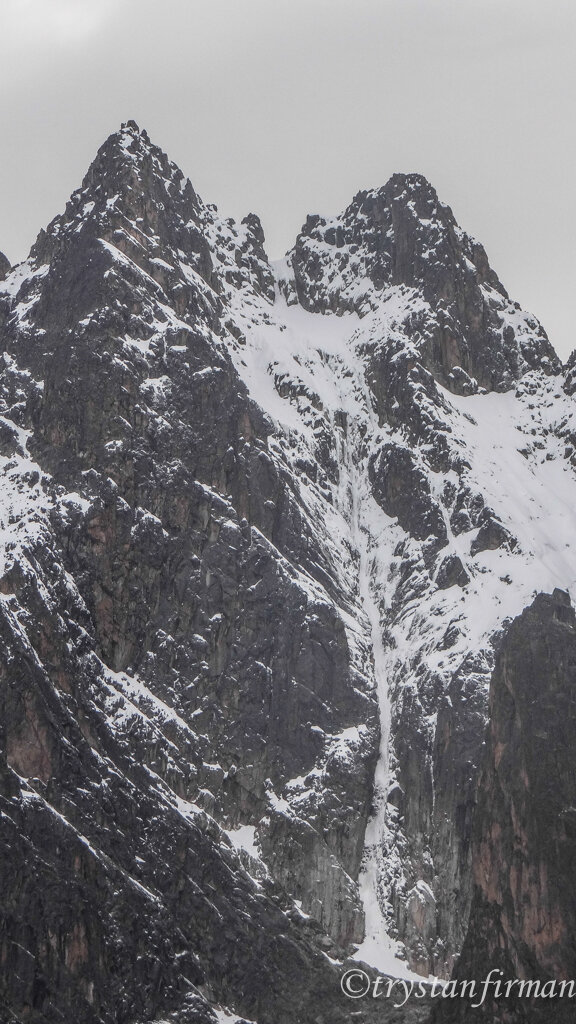Diamonds In The Snow
“The Diamond Couloir is not the hardest climb in the world, nor is it the most dangerous. But this striking line of equatorial ice might well be the most exotic. And now, 13 years after mountaineers thought it was lost for ever, the world’s most improbable ice route has been scaled again.”
In October 2018 Julian Wright and Tristan Firman from Vertigo Adventures climbed the “Diamond Couloir”, a route on Mt Kenya that was last climbed in 2005.
Here Tristan writes his account of the climb
Out of the corner of my eye I catch sight of my belay device bouncing twice on the ice and then pin-balling out of sight down the Super Couloir. Julian is somewhere far above in the swirling wind and snow, out of earshot, at the final stance and oblivious to my plight – one of us finished our ascent, the other fighting one last battle to get there.
Julian Wright and I met at the Mountain Club of South Africa’s national search and rescue training camp in 2017. He’d popped down with some fellow East African Guides to join in the 4-day technical training. We got along, and had shared interests: both of us operated Mountain Guiding outfits, both of us quite enjoyed the Alpine and Alpine Ice…and both liked the idea of demystifying the Diamond Couloir on Mt Kenya.
Originally opened by Phil Snyder and Thumbi Mathenge in 1973, as a steep snow couloir - the terrain such that despite Mathenge having never climbed before - the pair were able to make an ascent in hobnail boots and cutting steps where needed. Chouinard straightened their line higher up by tackling the vertical ice headwall directly in ’75, and thus “the most aesthetic climb on Mt Kenya” became an international icon. Changes in weather over the years have shrunk the glacier below to the point where the start of the route is now some 60m lower, and the lack of thick snow cover has exposed two rock steps low down on the route, as well as making the entire route steeper. Seemingly the crux is no longer Chouinard’s headwall, but the overhanging steps down low, once covered by snow.
Kitty Calhoun and Jay Smith climbed the Full Diamond in 2005, reporting: “M7 dry tooling on overhanging volcanic rock, leading to 165 feet of thin WI 5 ice. This long pitch gained the still-formed traditional route…”. Jim Donini and Brad McMillon repeated the route the following day and, as best we can tell, were the last ascent.
In late June ’18 I transited through Nairobi en route from Chamonix to Cape Town, and we set off for what turned out to be step one of our demystification. Whilst we never climbed to Diamond, we did learn a few things, and as consolation I ski’d The Lewis Glacier from 80ft below Pt Lenana all the way to The Lewis Tarn.
I returned to Cape Town and we agreed to keep in contact to see if the end of winter had brought about a change in conditions. In late September ’18 I arrived in Nyanuki fresh off of a trip to The Drakensberg in South Africa and Julian, well, Julian has Mt Kenya lungs, so we walked in from the Naro Moru Gate directly up to The Blackhole bivi at 4300m. This was our staging point in June when we were stopped on pitch 2, where the steep ice merged into verglassed rock with the lip a tantalizing 5m above, slightly overhung…with ice to thin for my bravery at the time. Now at the back-end of winter we hoped for either more ice, or more rock (either, just not the verglass) – and I’d brought the kitchen sink as backup. Hooks, camhooks, snargs, birdbeaks, rurps, aiders…and a better attitude. As a result, our morning packing was more of the mindset of cursory inspection of the low crux than expecting any sendage, and the second’s pack bore the weighty hallmarks of that mindset.
Heavy in gear, light in supplies!
Jules got the first pitch and then hauled while I self belayed. Higher a few popped tools in the fragile, steep, Ice got me into my aiders (perhaps a little to eagerly), aiding off of a spare tool and some peckers until able to throw a tool over the lip, clip an aider and pull onto the more sensible-angled terrain. Two pitches later, with the angle now more regularly in the AI4 range, we suddenly found ourselves, slightly unexpectedly, in a position where there was no point in rappelling back to the bivi. Inspecting our wares revealed 1 salami, 4 energy-bars, 4 GU sachets, 2 coffee’s and 2 soups, so we just accepted that we were now, also, signed up to a 2 or 3 day weight-loss program.
I guess that is what you get for packing for failure and not success!
We stopped to brew on the only sit-down ledge (as it turned out) on the entire route:
“Shall we bivi here”?
“meh, we’ve still got a couple of hours light…and it’s a waterfall in here, let’s do another few pitches”
With that the Diamond Glacier sent down a barrage of debris reminding us that, while couloirs are great to climb, they are, also, natural bowling alley’s. Two pitches later and Julian got sandbagged by the allure of bivi-ledge looking terrain out right (ably assisted by the unsighted belayer offering unsolicited advice) until eventually he gave up and stanced. Despite there being no alternative bivi-spots, and, being safely out of harms way, the hour we spent chopping passed in silence, but we conjured a 3x5 ft ledge just big enough for us to sit, brew…and share the only sleeping bag.
Of course, then it snowed. Wet, sloppy, miserable snow. Of course it was the middle of the night.
Faced with the prospect of getting drenched and then no doubt having to escape by retreating, we cut the single bivi down the middle giving us a rather expensive tarp – if you’re dumb enough to think that one bivi bag will suffice, I guess there’s a price to pay!
Morning brought blue skies, iced ropes and an unusual hunger for the summit. We rapped back into the couloir and continued to the headwall passing old belay stations which were 10-15m above us these days. We skirting Chouinard’s ill-formed direct exit by following the original route out left. Steep ice followed by steep sugar-snow followed by some mixed climbing got us onto the easier angled exit snow slopes left of the Diamond Glacier. The separate summits of Batian on the left, and Nelion on the right were beginning to take shape and we could smell the finish line. Julian belayed off of a big boulder perched in the hanging snow-field and I took over with the pitch which was to get us into the base of the final pitch of the couloir and, thence, the Gates of Mists. A long rising traverse gained us access to the final slopes and a fantastic looking belay on the left rock wall offered good gear after a pitch of absolutely nothing. Ten meters, nine meters…my progress slow from heaving lungs and fatigue and then halted by the ropes pulling at my harness.
Fuck.
Surveying the surroundings confirmed it – steep sugar snow everywhere except 7m above me. Still no gear between us, and there was the small matter of the haul bag making moving together impractical. Burying my main tool like a deadman, I untied and clipped the ropes to the tool and kicked steps to the rock wall, my right tool offering little assistance beside balance, where a belay was hatched and extended with all the slings, prussic and even the bandolier I had left, back down to the ropes.
The final pitch to the Gates of Mists was unnecessarily hard with the mind already having clocked out – I’m glad I never had the honors, but Julian seemed to enjoy it regardless.
We rested at the Gates, with Jules taking over the final pitch up to Nelion as it was familiar to him. While he climbed the unusually tricky pitch, the afternoon snow-storm arrived. Our system had been to haul first, then belay, so when the haul line came taught I lowered the pig out over the jagged rocks and boulders trying to make it easier to haul, only for it to get stuck. Fruitless shouting into the wind and snow left the pig down and left of me, Julian out of sight and all of us stationary. Unsure of whether I was on belay yet I crossed over to the haul line, sunk a tool and clipped in. Half an hour of exhaustive and maddening fighting with the terrain got the pig and I up to the easier ground. Pulling the pig around the corner onto the rock, the bag brushed the side of my harness and I watched blankly as my belay device bounced down the ice and into the Super Couloir. I just watched it go, no real feeling of anything, just resigned acceptance making the viewing academic.
We watched the sun rise from Nelion with Batian bathed in morning glow behind us and the forest way, way below steaming. Julian lead the descent, being well familiar with it. We’d contemplated doing the 12 rapp descent in the dark, but thankfully chose against it. Jules rapped a single rope length to the anchor, only to (not) find it under 4ft of Ice. After chopping for 20min we resolved to do a weird single-to-double-rope transfer and he continued to the next anchor – which required half an hour of chopping as well! A descending traverse got us onto the East Face proper and clean, dry, rock to the talus 300m below.
The stumble back took us past a Leopard carcass in the upper scree (the result of a fall from a ledge above, it would seem), a reminder of the wildness of Mount Kenya, but also of the harshness of Mountain environments. Lower we skirted the Lewis Tarn and stopped to hydrate with sweet water which must surely be infused with secret calorie nutrients, as the remaining walk down passed seemingly effortlessly.
Or, perhaps, that is just the nature of climbing mountains, the release of tension making the load lighter, and the memory of hardship more rosy.
A Breakdown of the Pitches
P1: 50m AI4 (solo to as high as comfortable, right side arguably safer from rock fall. Climb the access ramp until able to stance on left below the crux.
P2: 40m AI 5 A2 (this pitch varies in make-up. Fight your way up the “line of least resistance. May well require Aid / reasonably hard Mixed with poor rock gear)
P3: 40m AI4 (climb the 20m step.)
P5: 55m AI 4 (surmount bulge, continue up easier terrain, standing where suitable
P6: 55m AI 3
P7: 55m AI 3
P8: 40m AI 3
P9: 55m AI 4 (leave the main col where feasible, aiming for the rock prow. Here it is possible to branch right +-60m AI4)
P10: 50m AI 3 M5 (rising leftward ramps lead to easier ground)
P11: 40m AI 3 (P11-13 insecure once warm)
P12: 50m AI 3 (continue left/up standing at the lone exposed boulder)
P13: 60m (traverse right into final gully. Stance 15m left of exit fully rock wall. FULL 60m!)
P14: 50m AI 5. Exit to Gates of Mists)
If you would like to read the whole of The Times article click Here






